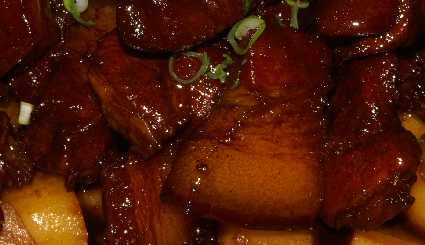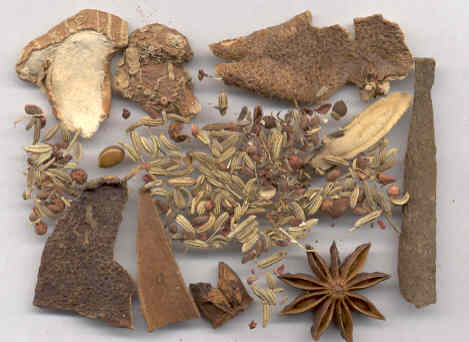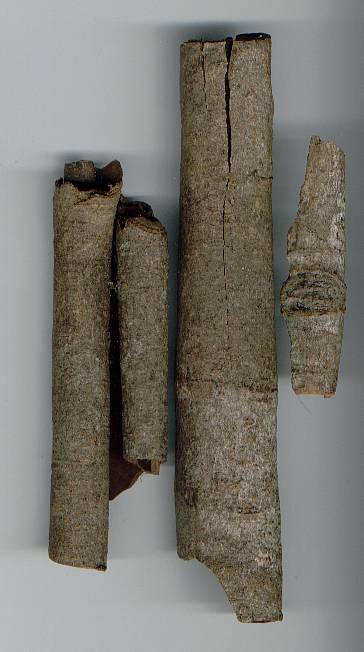
|
| Cassia flower |
Today, cassia is the preferred cinnamon species from peninsular South East Asia to Central Asia. In Western countries, Ceylon cinnamon is usually preferred for its purer and less harsh taste. Although cassia seems to be rather common in the US, it is hardly available in Europe unless in Chinese markets. Cassia can be substituted by cinnamon without loss of authenticity.
In Chinese cookery, cassia is an essential ingredient and used in the famous
five spice powder (see star anise) and
in spice mixtures of dried spices for slow-simmered hotpots (see
black cardamom). Together with other
spices, cassia is important for several Chinese cooking techniques
that use large amounts of aromatic liquid as a cooking medium.
The two best-known techniques of that kind are red cooking
or red braising (hongshao [红烧])
and master sauce cooking
(lushui zhi [鹵水汁]).

|
| Red-cooked pork belly (hongshao rou [红烧肉]) |
Red braising (hongshao [红烧]) means slow cooking in a mixture of dark soy sauce and spices. The cooking liquid is made from soy sauce (jiang you [酱油]), soy pastes (often sweet bean paste hoisin [Cantonese 海鮮醬, Mandarin 海鲜酱]), sugar and rice wine (liao jiu [料酒]), which are flavoured with fresh ginger, onion, garlic and dried spices up to the imagination of the cook. Most typical are cassia and star anise followed by black pepper, Sichuan pepper and even licorice. That liquid is used to cook large chunks of meats and poultry, which may be quickly fried and browned before cooking to improve the flavour. Typical cooking times range from half an hour for poultry to several hours for beef. Pork belly can also be prepared this way; made properly, it is delicious even if excessively greasy (hong shao rou [红烧肉]). By this type of cooking, the foods acquire a deep reddish–brown hue.
Although red braising is particularly associated with Hunan and Shanghai cooking,
it is practiced all over China, often with local variations. In Sichuan,
for example, hot bean paste (doubanjiang [豆瓣酱])
and broth is often taken as the base of the cooking liquid, and
dried chiles may be added. The finished
meat is often additionally flavoured with sesame
oil. This method is also referred as jiang shao [酱烧] braising with bean sauce
;
other related techniques are bai shao [白烧] white braising
(using a pale cooking liquid untainted by soy sauce) and
and cong shao [葱烧] onion braising
.

|
| Spice mixture for master sauce (鹵水料) made from orange peel, cassia, fennel, star anise, lesser galanga, Sichuan pepper and licorice. |
Cooking in master sauce
denotes a technique that uses a strongly salted and spiced
broth (lu shui [鹵水], literally salt water
)
as cooking medium. The broth may contain small amounts of soy sauce,
enough to taint the food brown. That spice broth is used to
cook meat, bean cheese or vegetables; meat is usually marinated with
ginger and scallions
and often blanched to prevent the broth from becoming foamy and
acquiring a raw
taste.
Master sauces may have varying composition, but typical flavourings
are rice wine, fresh ginger
and basically all the spices employed for red braising: Cassia,
star anise, orange
peel, fennel, Sichuan pepper
and licorice. Sichuan cooks will often use
additional spices like black cardamom and
lesser galangale. Mixtures of whole spices
for master sauces are often sold as lu shui liao [鹵水料]
grains for master sauce
.
The master sauce is not served; it may be diluted with fresh broth, rice
wine and soy sauce and re-used. To keep it from spoiling, it
should be reused or at least brought to a short boil every day,
which is indeed possible only in a restaurant; in Western households,
it is much more convenient to keep it in the freezer till next usage.
The more often the master sauce is used, the more aromatic and masterly
it tastes.
Both of the cooking methods outlined in the previous paragraphs are simple, but very effective. One of the reasons why they works so well is the alcohol content: alcohol facilitates the blending of flavours. To prevent the volatile alcohol from evaporating, the cooking pot must be closed carefully and the temperature should be kept at a slow simmer.
For a comparison of different cinnamon species, see Indonesian cinnamon.



